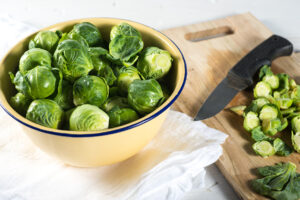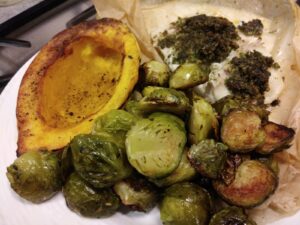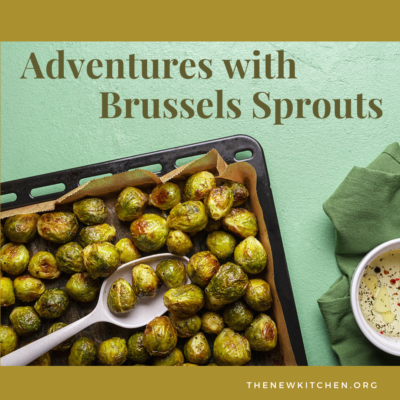In addition to being new in the kitchen and thinking, Meal Making Transformation is about being new in our cooking, which means getting comfortable with simple basic techniques, like vegetable roasting.
Do you harbor bad feelings about Brussels sprouts?
If so, there’s a good chance your Brussels trauma got embedded at a young age, at a time when the vegetable was boiled or steamed to death. The sprouts would get slimy, taste like rotted something–and yet you had to clean your plate! The result: Brussels trauma!
Explanations There are probably a couple reasons why those sprouts were pretty much a culinary bust.
First, remember there was a time when we weren’t blessed with gorgeous fresh produce shipped in from all parts of the globe. So a lot of cooks (usually moms) resorted to frozen vegetables to provide well-rounded meals. While I’m a big fan of frozen vegetables, not so much Brussels. Freezing only makes them easier to boil into a trauma-inducing side dish.
Secondly, I’m not sure why our kitchen forebears never roasted vegetables. They used ovens for lots of things (cakes, cookies and casseroles, for instance.) Happily, however, the 80s and 90s introduced vegetable roasting. For Brussels this was the dawn of a whole new era because roasting turns them into a whole new–and mightily delicious–vegetable.
Nowadays, walk in any Whole Foods and there in the deli counter will be a tray of lightly browned roasted Brussels, basking in the limelight.
The Goldilocks Problem When roasting Brussels, however, I have a hard time getting them just right, i.e., nicely browned on the outside, but cooked through so they aren’t still raw-ish tasting on the inside.
I’m thinking the problem stems from a fundamental characteristic of Brussels, i.e., they are both hard and dry.
Here’s why that’s a challenge: We roast things at high heat, like 400 (F), so the outside of the food gets flavorfully browned. But with a hard, dry vegetable like Brussels, the inside of the vegetable often doesn’t have enough time and moisture to cook through before the outside gets too brown, i.e., almost burned.
A Solution: Quick Pre-Cook I’ve been trying a one-two punch. First I microwave the Brussels for two minutes, until they just barely give when stuck with a fork. Then I roast. The little shot of pre-cooking ensures that the sprouts get cooked through by the time they are nicely browned on the outside.
Step-by-Step Instructions More specifically, for 4 cups of sprouts (2 servings), I:
Preheat the oven to 400(F)
- Trim the ends of sprouts, but just barely so I don’t waste a big hunk of them.

- Halve the bigger ones so they all come out roughly the same size and will roast evenly.
- Place in a baking dish big enough so spouts can fit in a single layer but still be touching so they can better retain their moisture.
- Toss and rub with 1 Tbsp. olive oil.
- Sprinkle with sea salt and freshly ground pepper, to taste.

- Cover the dish and microwave 2 minutes, more or less depending on your microwave’s power.
- Stick with a fork to see if they give just slightly–err on less rather than more microwaving.
- Uncover the sprouts so they can brown–very important, see Caution below.
- Place in oven and roast about 30-40 minutes, stirring and turning a couple times, until they are sweetly browned and no longer taste raw’ish on the inside–which will be a matter of personal taste.

Caution: DON’T Do This On Thanksgiving, I learned that while some is good, more is not always better. After microwaving my Brussels, I lightly covered the baking dish with foil when I put it in the oven, to make sure the sprouts got cooked through. Big mistake. By the time I removed the foil so the sprouts could brown, they had mostly steamed and had lost a lot of their flavor.
I tried, fairly successfully, to cover up the taste that was slightly reminiscent of the Brussels from my youth. I did a pretty good job with a roasted garlic sauce (that I’ll share in the near future) but it was a little disappointing : (
For the batch pictured above, I did not make that mistake and the sprouts were perfect : )

1 thought on “Recipe: Adventures with Brussels Sprouts . . . and the Goldilocks Problem”